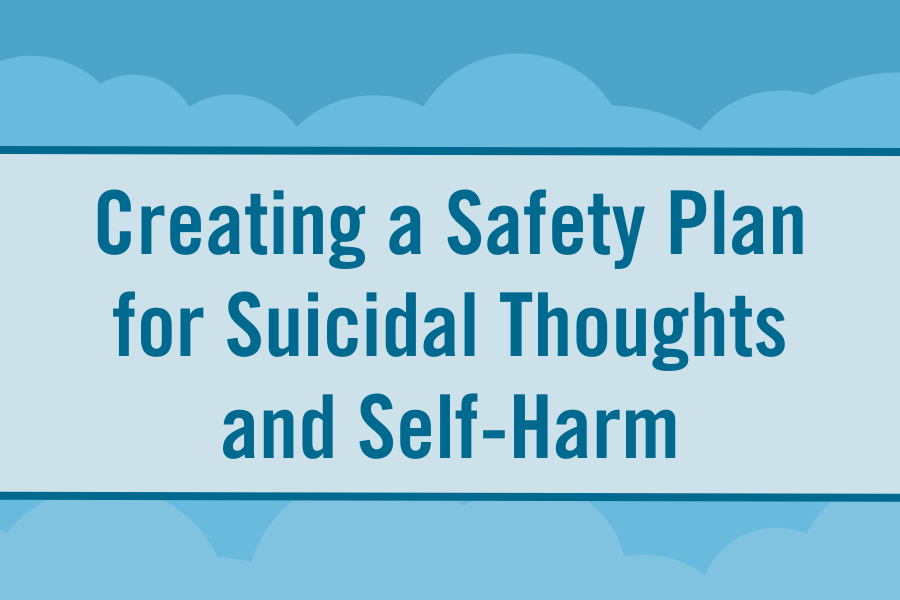At Distress Centre, we create safety plans with our service users every day.
A safety plan can be an effective tool to help mitigate self-harm and suicidal behaviours. The purpose of a safety plan is to help you cope with and distract you from suicidal thoughts and thoughts of self-harm, so you can get through the initial state of intense crisis and cope until the feelings have passed or you are able to connect with further help. A safety plan is not a quick fix that will permanently remove all thoughts of suicide and self-harm. It is a coping tool to help you get through the immediate crisis.
Drafting a safety plan is best done collaboratively. You do not have to be a professional to help draft a safety plan. If there is someone in your life whom you think would benefit from a safety plan, you can assist them in creating one. If the plan is for you, ask someone you trust to craft it with you or contact Distress Centre and we can create one with you.
This article will walk you through the process of creating a safety plan for yourself or assisting someone else in the creation of their safety plan.
Safety Plan Creation
Please Note: If someone is at imminent risk of harming themselves, safety planning is not possible. Call 911.
You cannot create a safety plan if you are currently in crisis. Develop it when you are relatively calm so that it can be easily referred to when a crisis or suicidal thoughts arise.
It is not appropriate to create a safety plan if you are intoxicated or using drugs, or if your mental health is currently affecting your perception of reality.
If someone is in crisis, follow these guides to help them. You can always contact Distress Centre for support. Phone or text: 403-266-4357
The Steps of a Safety Plan
There are six steps to a safety plan. When you experience thoughts of hopelessness, self-harm, or suicide, it can be difficult to see a way out. The six steps help you work through your coping skills independently and determine when you need outside assistance.
Go through the steps in order and only move on to the next step if the previous step is proving ineffective.
Learn about the six steps to include in a safety plan or use a template:
Step One – Warning Signs
It is important to pay attention to yourself and recognize the warning signs of an impending crisis. What are your warning signs? How do you feel physically and emotionally leading up to thoughts of suicide or self-harm? Are there increasing feelings of depression, irritability, or hopelessness? Do you have trouble sleeping? Do you spend increasing amounts of time alone? Write down any warning signs you’ve experienced.
Step Two – Internal Coping Strategies
Once you notice the warning signs of an impending crisis, it is time to employ your internal coping strategies. You can do these things on your own to distract yourself from thoughts and feelings of hopelessness. Some ideas are getting outside for a walk, listening to upbeat music, taking a shower, playing a video game, or playing with a pet. These are activities that would also appear in a personalized self-care plan (link). Write down your coping strategies.
Step Three – Social Strategies
Step three is using social contacts and social settings as a means of distraction. This can be direct socialization with a friend or family member, or simply stepping into a social setting, like a coffee shop or place of worship. You don’t need to explicitly reveal your state of mind at this time. Brainstorm who you could connect with and how or where you could go and write these social strategies into step three of your safety plan.
Step Four – Support Person
If steps one through three aren’t proving effective, it is time to explicitly reveal to someone that you are in crisis and need support. When creating your safety plan, choose a trusted person to be that support person. If possible, identify multiple people who can fill this role. This way you have another option in case the first person you contact is unreachable. Talk with this trusted person ahead of time so they are aware of your situation and your safety plan. They can let you know if they are prepared to be your support person. List the contact information and availability of your support person or persons in your safety plan.
Step Five – Professional Help
If steps one through four have been ineffective, it is time to contact mental health professionals or agencies. Some options are: your counsellor, Distress Centre, 911, and 211. Write out the names and contact information.
Step Six – Restrict Access
Finally, as part of your safety planning, it is paramount to restrict access to lethal means – anything that could be used to harm yourself. Identity and eliminate or restrict access to any potentially lethal means. This may include safely storing of firearms as well as limiting access to medication.
Updating a Safety Plan
Once you have created your safety plan, keep a copy in an easily accessible location.
A well-designed safety plan is flexible and should be revised and updated as often as needed. At any time, the plan can be reviewed, especially if you find that a portion is ineffective in helping you cope. Make sure to keep contact information up-to-date, change coping strategies when they become less effective or accessible, and change contact persons as needed.
Remember, Distress Centre is here for you if you need support. Phone or text: 403-266-4357 or chat online through the chat portal:

